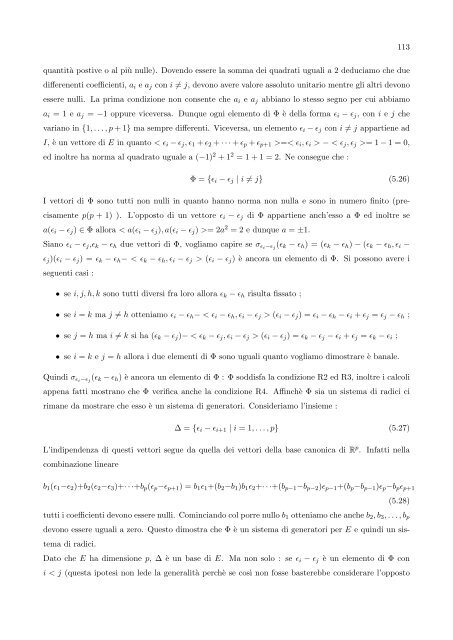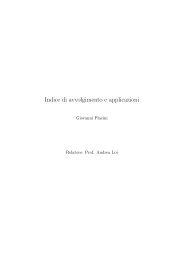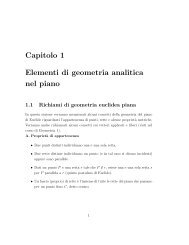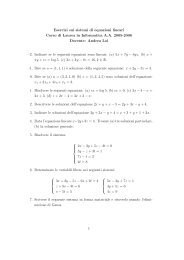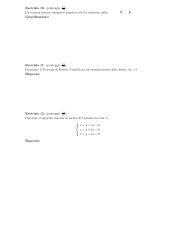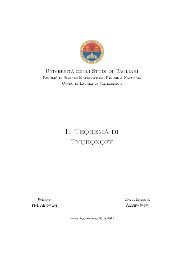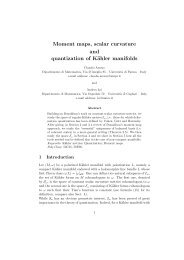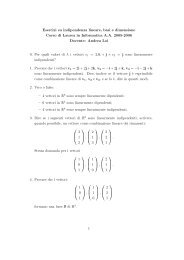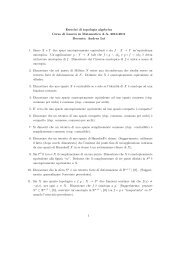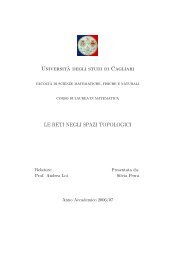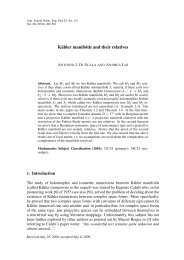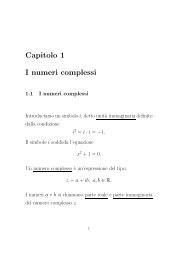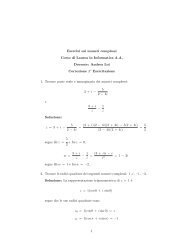Algebre di Lie semisemplici, sistemi di radici e loro classificazione
Algebre di Lie semisemplici, sistemi di radici e loro classificazione
Algebre di Lie semisemplici, sistemi di radici e loro classificazione
You also want an ePaper? Increase the reach of your titles
YUMPU automatically turns print PDFs into web optimized ePapers that Google loves.
quantità postive o al più nulle). Dovendo essere la somma dei quadrati uguali a 2 deduciamo che due<br />
<strong>di</strong>fferenenti coefficienti, ai e aj con i = j, devono avere valore assoluto unitario mentre gli altri devono<br />
essere nulli. La prima con<strong>di</strong>zione non consente che ai e aj abbiano lo stesso segno per cui abbiamo<br />
ai = 1 e aj = −1 oppure viceversa. Dunque ogni elemento <strong>di</strong> Φ è della forma ɛi − ɛj, con i e j che<br />
variano in {1, . . . , p + 1} ma sempre <strong>di</strong>fferenti. Viceversa, un elemento ɛi − ɛj con i = j appartiene ad<br />
I, è un vettore <strong>di</strong> E in quanto < ɛi − ɛj, ɛ1 + ɛ2 + · · · + ɛp + ɛp+1 >=< ɛi, ɛi > − < ɛj, ɛj >= 1 − 1 = 0,<br />
ed inoltre ha norma al quadrato uguale a (−1) 2 + 1 2 = 1 + 1 = 2. Ne consegue che :<br />
113<br />
Φ = {ɛi − ɛj | i = j} (5.26)<br />
I vettori <strong>di</strong> Φ sono tutti non nulli in quanto hanno norma non nulla e sono in numero finito (pre-<br />
cisamente p(p + 1) ). L’opposto <strong>di</strong> un vettore ɛi − ɛj <strong>di</strong> Φ appartiene anch’esso a Φ ed inoltre se<br />
a(ɛi − ɛj) ∈ Φ allora < a(ɛi − ɛj), a(ɛi − ɛj) >= 2a 2 = 2 e dunque a = ±1.<br />
Siano ɛi − ɛj,ɛk − ɛh due vettori <strong>di</strong> Φ, vogliamo capire se σɛi−ɛj (ɛk − ɛh) = (ɛk − ɛh) − (ɛk − ɛh, ɛi −<br />
ɛj)(ɛi − ɛj) = ɛk − ɛh− < ɛk − ɛh, ɛi − ɛj > (ɛi − ɛj) è ancora un elemento <strong>di</strong> Φ. Si possono avere i<br />
seguenti casi :<br />
• se i, j, h, k sono tutti <strong>di</strong>versi fra <strong>loro</strong> allora ɛk − ɛh risulta fissato ;<br />
• se i = k ma j = h otteniamo ɛi − ɛh− < ɛi − ɛh, ɛi − ɛj > (ɛi − ɛj) = ɛi − ɛh − ɛi + ɛj = ɛj − ɛh ;<br />
• se j = h ma i = k si ha (ɛk − ɛj)− < ɛk − ɛj, ɛi − ɛj > (ɛi − ɛj) = ɛk − ɛj − ɛi + ɛj = ɛk − ɛi ;<br />
• se i = k e j = h allora i due elementi <strong>di</strong> Φ sono uguali quanto vogliamo <strong>di</strong>mostrare è banale.<br />
Quin<strong>di</strong> σɛi−ɛj (ɛk − ɛh) è ancora un elemento <strong>di</strong> Φ : Φ sod<strong>di</strong>sfa la con<strong>di</strong>zione R2 ed R3, inoltre i calcoli<br />
appena fatti mostrano che Φ verifica anche la con<strong>di</strong>zione R4. Affinchè Φ sia un sistema <strong>di</strong> ra<strong>di</strong>ci ci<br />
rimane da mostrare che esso è un sistema <strong>di</strong> generatori. Consideriamo l’insieme :<br />
∆ = {ɛi − ɛi+1 | i = 1, . . . , p} (5.27)<br />
L’in<strong>di</strong>pendenza <strong>di</strong> questi vettori segue da quella dei vettori della base canonica <strong>di</strong> R p . Infatti nella<br />
combinazione lineare<br />
b1(ɛ1−ɛ2)+b2(ɛ2−ɛ3)+· · ·+bp(ɛp−ɛp+1) = b1ɛ1+(b2−b1)b1ɛ2+· · ·+(bp−1−bp−2)ɛp−1+(bp−bp−1)ɛp−bpɛp+1<br />
(5.28)<br />
tutti i coefficienti devono essere nulli. Cominciando col porre nullo b1 otteniamo che anche b2, b3, . . . , bp<br />
devono essere uguali a zero. Questo <strong>di</strong>mostra che Φ è un sistema <strong>di</strong> generatori per E e quin<strong>di</strong> un sis-<br />
tema <strong>di</strong> ra<strong>di</strong>ci.<br />
Dato che E ha <strong>di</strong>mensione p, ∆ è un base <strong>di</strong> E. Ma non solo : se ɛi − ɛj è un elemento <strong>di</strong> Φ con<br />
i < j (questa ipotesi non lede la generalità perchè se così non fosse basterebbe considerare l’opposto


